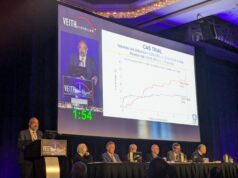
Avoiding a strategy of post-stent balloon dilation during transcarotid artery revascularization (TCAR) may be unnecessary—a “contradistinction” to results shown in conventional transfemoral carotid artery stenting, new research has shown.
Jones Thomas, MD, an integrated vascular surgery resident at University Hospitals Cleveland Medical Center in Cleveland, Ohio, and colleagues analyzed data garnered from the ROADSTER trials, demonstrating that there was no difference in adverse outcomes between the type of balloon dilatation strategy: either pre-stent dilation only, post-stent dilation on its own or a combination of both.
Thomas and colleagues were prompted to study TCAR balloon dilation strategy outcomes in light of concerns over neurological risk and hemodynamic instability raised with post- and a combination of pre- and post-stent dilatation during transfemoral stenting. This may not be applicable to TCAR, which uses cerebral blood flow reversal during stent deployment and balloon angioplasty, Thomas told the Vascular & Endovascular Surgery Society (VESS) Spring Meeting (Aug. 18), held at the Vascular Annual Meeting (VAM).
He referenced studies that show a 2.4 times greater risk of stroke and 3.8 times increase in hemodynamic instability associated with the transfemoral approach. “Research has also shown hemodynamic instability can lead to increased myocardial infarction [MI], length of stay and mortality,” Thomas said.
Analyzing primary outcome measures of stroke, death and MI at 30 days among 851 eligible patients from the ROADSTER trials, the research team discovered overall results that showed 1.9% had a stroke, 0.5% died and 0.9% suffered an MI.
“We saw that there was no difference in overall adverse outcomes between the three dilatation strategies,” Thomas explained. “We separated the cohort between symptomatic and asymptomatic patients, and while there were a larger number of adverse outcomes in the symptomatic arm, again, between the dilatation strategies, there were no differences.”
He highlighted limitations, including the non-randomized nature of the trial data and the fact choice and discretion regarding dilatation strategy was left up to the operator.
“Based on this prospective trial data, there does not appear to be any difference in neurological complication due to the balloon dilatation strategy, especially with post-stent dilatation during TCAR,” Thomas concluded.
“We feel that avoiding post dilation may be unnecessary during TCAR, which is a contradistinction to results from transfemoral carotid artery stenting. Whether post dilation enhances stent durability, decreases restenosis, reduces reinterventions—that I think remains unknown at this time. But these findings at least support the need for longer-term studies to evaluate those factors.”
Speaking from the audience designated discussant Julie Duke, MD, an assistant professor and associate program director of the vascular residency and fellowship at the University of Minnesota in Minneapolis, queried Thomas about how the data had affected his team’s practice.
“This study gives two major things we can take away: reassurance, regardless of which dilation strategy you’re choosing to use at this time, that you’re not adversely affecting the patients,” he answered. “That being said, I think it also gives us some data to support the fact that, if we’re doing post-stent dilation, we’re not hurting the patient. That could be important when we look at stent deployment in other vessel beds.”
Thomas added, “We think that now we have shown—at least in this population—that post dilation doesn’t lead to negative outcomes, then we should look into what the positive outcomes will be.”











